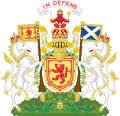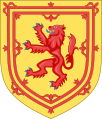Banner
A banner can be a flag or another piece of cloth bearing a symbol, logo, slogan or another message. A flag whose design is the same as the shield in a coat of arms (but usually in a square or rectangular shape) is called a banner of arms. Also, a bar-shaped piece of non-cloth advertising material sporting a name, slogan, or other marketing message is also a banner.
For other uses, see Banner (disambiguation).
Banner-making is an ancient craft. Church banners commonly portray the saint to whom the church is dedicated.
The word derives from Old French baniere (modern French: bannière), from Late Latin bandum, which was borrowed from a Germanic source (compare Gothic: 𐌱𐌰𐌽𐌳𐍅𐌰, romanized: bandwa). Cognates include Italian bandiera, Portuguese bandeira, and Spanish bandera.
A heraldic banner, also called a banner of arms, displays the basic coat of arms only: i.e. it shows the design usually displayed on the shield and omits the crest, helmet or coronet, mantling, supporters, motto or any other elements associated with the full armorial achievement (for further details of these elements, see heraldry). A heraldic banner is usually square or rectangular.
A distinction exists between the heraldic banner and the heraldic standard. The distinction, however, is often misunderstood or ignored. For example, the Royal Standard of the United Kingdom is in fact a banner of the royal arms.
Advertising banners[edit]
Often fabricated commercially on a plastic background, the banner industry has developed from the traditional cut-vinyl banners to banners printed within large, ultra-wide format inkjet printers on various vinyl and fabric materials using solvent inks and ultraviolet-curable inks.
Banners are used in many business ventures, marketing to their potential audience. A number of British towns and cities have whole series of banners decorating their city centers, effectively advertising the town or its special features and attractions. Pre-printed banners, albeit commonly used, are simple and accessible. Banners can be printed in enormous formats, with a full range of rich colors. They can also be used in many different physical situations whether it be hanging from an existing fixture, fixed to a wall or even free standing. When an advertising banner is hung or suspended between posts, grommets or another method of attachment are necessary to prevent the banner from tearing or flying away. Aluminum grommets can be punched into the banner and used as secure entry points to tie the banner down. This installation method allows for more durable advertisements. Some vendors offer pre-installed grommets. Another common form of free standing banners are retractable displays.
Banners can be found plastered behind a window screen, as billboards, atop skyscrapers, or towed by airplanes or blimps. As with variable of size and quantity, the number of sides and quality of ink are as much of a crucial factor. In an instance of retail stores which purchase pre-printed clearance banners, or a variety of sale banner. A banner facing underneath or against glass is absorbing exposure from the sun. A banner printed on UV outdoor ink will last several years to a decade where cheaper ink fades, requiring frequent replacement. Being behind glass, a two-sided banner can be displayed from the inside and out, often building recognition between shoppers and caretakers. Three-sided banners are often appealing as there is dimension and can be embellished differently. The more sides that exist, the more angles the banner covers, which is a possibility where a two-sided banner doesn't face the viewer from center of the room or streets.
Another manifestation of advertising banners, unique to the 21st century, are "banner ads",[2] which are advertisements on websites. The banner ads contain hyperlinks to other websites. Also, on free music streaming services such as Spotify and Pandora, audio advertisements will play in between songs. One of the common tag lines is "Click the banner to learn more."
Big letter banners (China)[edit]
In China, it is common to find large red coloured banners, especially in schools, factories, government institutions and construction sites. Also called da zi bao (Chinese: 大字报; pinyin: dàzìbào; lit. 'big-character reports'), these tend to be big and long, usually with red backgrounds and large Chinese characters. They tend to have motivational messages or industrial milestones on them. Historically, these big character posters (da zi bao) were used to convey messages during the cultural revolution, but their use changed after the country's liberalization since 1979.[3]





